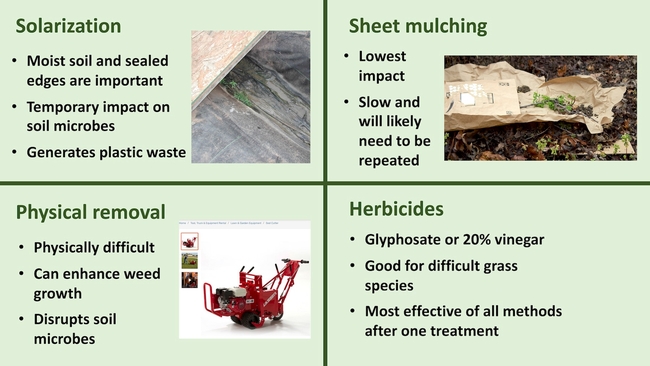I've spoken with countless gardeners over the years who wish to start their own bee haven. That's great -- the bees need all the help we can give them. But the most misunderstood part of the process is how much preparation needs to take place before a single plant goes in the ground.
As the Haven winds down, I'd like to share some tips on preparing to install your own bee garden.
Many gardeners are removing a turf lawn to create their bee haven. It's important to take the time to do this correctly so your garden doesn't revert to a weedy mess. UC IPM has great information about turf removal, including how to identify your turf species (knowing your species helps with removal) and how to remove existing turf.
If you are opposed to using herbicides to kill your lawn, solarization can also be used. For most lawns it will take longer and be less effective. That is definitely the case for bermudagrass lawns that are common in California. Figure 1 summarizes the pros and cons of various turf removal methods. For more own bermudagrass lawn, I used a combination of herbicides, sheet mulching, and hand removal.
Finally, weed barrier fabric is never recommended. It prevents ground-nesting bees from accessing the soil, traps weed seeds that grow through the fabric and become impossible to remove, and breaks down over time to leach microplastics into the ground.
Whatever methods you use, patience is key. Plan on at least one year of preparation before planting.

It's also essential to know your soil type and its physical characteristics. Jar tests and drainage tests provide important information about how your soil will hold water. In California, the UC Davis Soil Web has detailed soil maps; these may be less accurate if you are in a new development where there has been recent soil disturbance or addition of new topsoil.
Finally, watch the pattern of sun and shade in your garden for a year before planting. Many winter-blooming 'full sun' plants will do fine under deciduous trees as they are in full sun when flower buds are forming. In the hotter part of California, some 'full sun' plants may need shade in afternoon.
The final task while you're in the process of killing your lawn is to learn about and choose plants for your garden. Garden tours are a great way to start this process....you'll see what grows in your area and have the chance to speak to other gardeners. These are often sponsored by municipal water authorities. Botanic gardens and independent garden centers with knowledgeable staff are other great resources.
The UC Master Gardener program has trained volunteers throughout the state to provide research-based gardening information. They are a fantastic resource and hold educational programs like this one for the public. Finally, garden clubs and the California Native Plant Society hold tours, plant sales, and educational events.